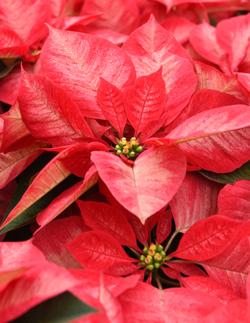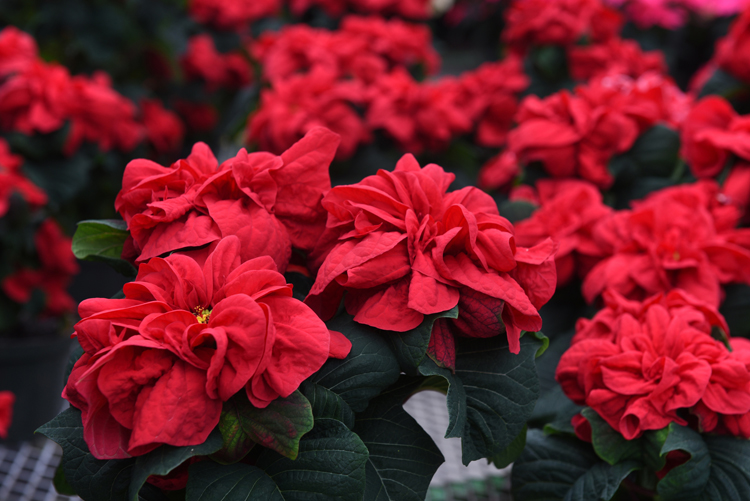Poinsettias; How to choose, grow and make them last
Posted on: December 7, 2017 | Written By: Doug Oster |
A sea of red, cream and pink greets visitors as they enter the warm and humid greenhouses at Janoski’s Farm and Greenhouse in Clinton. They’ve been growing poinsettias here since 1972, back when just about every plant was red.
“There’s been a lot of changes since then,” says owner Mike Janoski, who starts nearly 40,000 poinsettias in late summer from tiny plants.

Janoski’s Farm and Greenhouse in Clinton has been filled with poinsettias since 1972. Photos by Doug Oster
Although traditional red is still the biggest seller, there are lots of different colors, shapes and sizes of the plant. It’s essential, when looking for the best plants, to search out something grown locally, Janoski says. “We want the best quality we can get and that’s how you get quality.”

Horticulturist Sonia Weese
Horticulturist Sonia Weese agrees. She is a grower at the Drew Mathieson Center, which is part of Bidwell Training Center’s horticulture program on Pittsburgh’s North Side.
“You run the risk of damage when shipping,” she says.
It’s actually the bract — a specialized or modified leaf below the flower — that colors up on poinsettias, the tiny flower is located in the center of the bract, and examining the flower is one way to know if the plant is in its prime.

One way to tell if a poinsettia is fresh and will be long lasting is to look at the flowers in the center of the plant. This poinsettia is perfect as the beads are tight with just a little yellow coloration. It’s one of the varieties at Janoski’s Farm and Greenhouse in Clinton.
“Look at the beads,” Janoski says of the little flowers. “It should be a greenish, reddish color.”
If they are yellow, the plant has been ripe for a long time and usually on the decline. Also look at the bracts themselves, he says. The tops will be filled with color, the lower bracts should be transitioning from green to their color.
Buying poinsettias should be the last stop of the day too. They are very sensitive to cold and if the plant sees freezing temperatures, it will die.
“When we sell them here, we put a sleeve around them and that holds the heat in when you’re going from here to the car,” he says.
VARIETIES TO CHECK OUT
‘Princettia’: The ‘Princettia’ series debuted a few seasons ago with a pure white flowering variety, but is also available is soft pink.
“They have a great shape,” Weese says. “They are nice and compact. The flowers are smaller, but sit really well and present really well.”
Since the plant is a little stockier, it’s a great choice as a centerpiece on the table as guests will be able to converse without rubbernecking around a huge pot.
‘Winter Rose’: This unconventional cultivar has double flowers.
“I do love the unique texture and the shape,” Weese says. “It’s more of an upright plant. The unique flowers are really a draw.”
POINSETTIA CARE TIPS
• The plant can live on the windowsill for the entire winter, and it can even be grown in the garden starting in late May.
• There’s no need to fertilize them until late February, Janoski says, and they will grow best in a brightly lit window.
• Don’t overwater the plant, that’s the worst mistake that can be made. “Pick the plant up and see how heavy it is,” he says. If it’s light, the pot needs some water, if heavy, just wait. If it’s growing by a heat duct, the plant might need water every day.
• Even though poinsettias are technically poisonous, their white sap is bitter. It would take dozens of plants to get someone sick.
HOLIDAY TRADITION
As Christmas Eve approaches, Janoski hopes for “empty tables.” He has seen many regular customers return annually, it’s one of the things he loves about the season.
“It’s a tradition,” he says. “Some guys come with their daughter or a mom with daughter, you see some the same faces on the same day before Christmas.”

‘Winter Rose’ has distinctive double bracts and are a popular plant as they last well through the winter. It’s one of the varieties at Janoski’s Farm and Greenhouse in Clinton.
Doug Oster is editor of Everybody Gardens, a website operated by 535Media, LLC. Reach him at 412-965-3278 or doster@535mediallc.com. See other stories, videos, blogs, tips and more at everybodygardens.com.